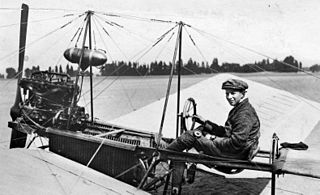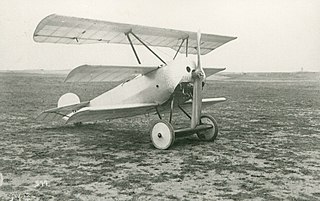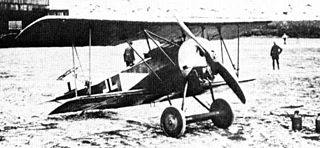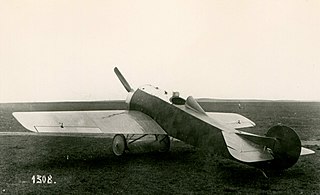
The Fokker D.VII was a German World War I fighter aircraft designed by Reinhold Platz of the Fokker-Flugzeugwerke. Germany produced around 3,300 D.VII aircraft in the second half of 1918. In service with the Luftstreitkräfte, the D.VII quickly proved itself to be a formidable aircraft. The Armistice ending the war specifically required, as the fourth clause of the "Clauses Relating to the Western Front", that Germany was required to surrender all D.VIIs to the Allies. Surviving aircraft saw much service with many countries in the years after World War I.

The Fokker M.5 was an unarmed single-seat monoplane aircraft designed and built by Anthony Fokker in 1913. It served as a light reconnaissance aircraft with the German army at the outbreak of World War I and was the basis for the first successful fighter aircraft in German service, the Fokker E.I.

The Fokker Spin was the first airplane built by Dutch aviation pioneer Anthony Fokker. The many bracing wires used to strengthen the aircraft made it resemble a giant spider, hence its name Spin, Dutch for "spider".

The Fokker V.6 was a prototype fighter triplane developed in Germany during World War I in parallel with the V.5, from which the famous Dr.I was developed. The V.6 was powered by an 89 kW (120 hp) Mercedes D.II liquid-cooled engine. The heavier engine required larger wings, with the lower wing being placed just below the fuselage. A modification to add fairings to the lower wing fuselage junction was implemented after the first tests. The V.6 was abandoned in October 1917 due to being inferior in maneuverability to the newer Dr.I.

The Fokker V.7 was a prototype German fighter triplane of World War I, an attempt to improve upon the Dr.I by using the experimental Siemens-Halske Sh.III, double acting rotary engine.. To make use of the higher power and rpm, the aircraft had a four-bladed propeller of larger diameter than the Dr.I. This required longer landing gear. The rear fuselage had to be extended to compensate for the heavier engine. Four V.7 aircraft were built. The performance of the V.7 was outstanding, but the engine was not ready for service. The Fokker V.7/I was converted to a Dr.I.

The Fokker V.4 was a prototype German fighter aircraft of World War I. Inspired by the successful Sopwith Triplane, Anthony Fokker chose to create a triplane fighter. Reinhold Platz was responsible for the design. The V.4 looked very much like the later Dr.I, but is easily recognized by the lack of interplane struts. All three wings were cantilever and the lower two wings had the same span. The rudder was balanced, but the ailerons and elevators lacked horn balances.

The Fokker V.1 was a small German sesquiplane experimental fighter prototype built in 1916 by the Fokker-Flugzeugwerke. Sporting a parasol wing, it was the first Fokker aircraft purportedly designed by Reinhold Platz—the respective roles played by Fokker himself, Platz, and possibly others in the conceptual design of Fokker airplanes are a matter of dispute among historians—and was an early experiment in cantilever wing construction, eliminating the bracing wires typical of aircraft design at the time, something that had already been achieved with metal materials in Hugo Junkers' own pioneering Junkers J 1 in 1915.

The Fokker V.2 and V.3 aircraft were developed from the Fokker V.1, but utilized an 89 kW (120 hp) Mercedes liquid-cooled inline engine instead of the rotary. This is similar to the Fokker V.6 being tested as the Fokker V.5 was being developed. Like the V.1, the fuselage was circular in cross section, and the wings were covered with plywood. To match the center of pressure and center of gravity with the heavier engines, these aircraft had their upper wing's outboard sections swept back.

The Fokker D.VI was a German fighter aircraft built in limited numbers at the end of World War I. The D.VI served in the German and Austro-Hungarian air services.

The Fokker V.17 and its derivatives were a series of experimental monoplane Fighter aircraft produced by the Dutch aircraft company Fokker in the 1910s.

The Fokker V.27 was a German parasol-monoplane fighter prototype designed by Reinhold Platz and built by Fokker-Flugzeugwerke.

The Fokker M.6 was a two-seat experimental design resembling the later E.I fighter. It had a 60 kW (80 hp) Oberursel engine and first flew in June 1914.

The Fokker M.7 was a German observation aircraft of World War I, used by the armed forces of both Germany and Austro-Hungary.

The Fokker A.I was an "A-class" unarmed two-seat monoplane observation aircraft of the 1914-15 era early in World War I, powered as the earlier Fokker M.5 was, by a 58.8 kW (80 PS) Oberursel U.0 seven cylinder rotary engine, or umlaufmotor, a near-clone of the Gnome Lambda rotary engine of the same power output level — the same U.0 seven cylinder rotary engine version was used on all Fokker military monoplanes before the Fokker E.II Eindecker fighter's debut in 1915-16. The A.I aircraft resembled a substantially enlarged Fokker M.5, with a tall dorsal cabane structure to handle the triple sets of stationary flying and landing wires anchored to the wing panels' forward spar, each panel having fourteen wing ribs, and the similarly triple sets of wing warping cables attached to the rear spar. The A.I and earlier A.IIs were both built by Fokker and license-built by Halberstadt. The origins of the A.I, A.II and A.III were in a Morane-Saulnier Type H purchased from France. This led to the initial Fokker M.5 airframe designed by Martin Kreutzer, from which the larger A.I was derived. Fokker gave many aerobatic demonstrations in the M.5 on the eve of World War I. The M.8, was ordered as the A.I by the Fliegertruppe and between Fokker and Halberstadt, about 63 were produced.

The Fokker K.I, company designation M.9, was a German experimental biplane built during World War I by the Fokker-Flugzeugwerke. It was intended to meet a need by the Fliegertruppen des deutschen Kaiserreiches for an aircraft that could defend itself against Entente fighters armed with machine guns. Fokker had had only limited resources available for the project and Anthony Fokker, the company's owner and chief designer, could not devote a lot of time or material to the K.I, given the demands on his time and the company's resources. The limited flight testing conducted by Fokker revealed multiple problems with the aircraft's center of gravity and structural strength. Resolving these issues was beyond Fokker's resources at that time and he ordered the K.I scrapped.

The Fokker M 10 was a two-seater reconnaissance / trainer biplane with single-bay wings equipped with wing-warping controls for roll, powered by a 7-cylinder 80 hp Oberursel U.0 engine. Several M 10 aircraft were purchased by the Imperial and Royal Aviation Troops of Austro Hungary.

Fokker V.8 was a five-winged aircraft built by Fokker for the Luftstreitkräfte during World War I.

The Fokker S.I was a Dutch primary trainer, first flown in 1919 and the first of a family of trainers from the Fokker company.

The Fokker V.39 was a prototype sports aircraft built by Fokker shortly after World War I based on a scaled-down version of the Fokker D.VIII fighter design and powered by an 82 kW (110 hp) Le Rhône engine.

The Junkers CL.I was a ground-attack aircraft developed in Germany during World War I. Its construction was undertaken by Junkers under the designation J 8 as proof of Hugo Junkers' belief in the monoplane, after his firm had been required by the Idflieg to submit a biplane as its entry in a competition to select a ground-attack aircraft.




















